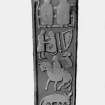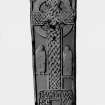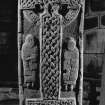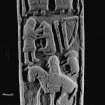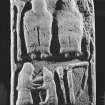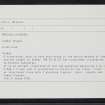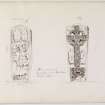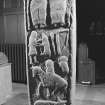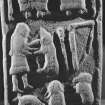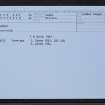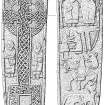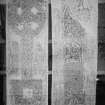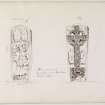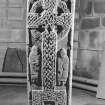Pricing Change
New pricing for orders of material from this site will come into place shortly. Charges for supply of digital images, digitisation on demand, prints and licensing will be altered.
Upcoming Maintenance
Please be advised that this website will undergo scheduled maintenance on the following dates:
Thursday, 9 January: 11:00 AM - 3:00 PM
Thursday, 23 January: 11:00 AM - 3:00 PM
Thursday, 30 January: 11:00 AM - 3:00 PM
During these times, some functionality such as image purchasing may be temporarily unavailable. We apologise for any inconvenience this may cause.
Brechin Cathedral
Cross Slab (Early Medieval)
Site Name Brechin Cathedral
Classification Cross Slab (Early Medieval)
Alternative Name(s) Aldbar Cross-slab
Canmore ID 35067
Site Number NO56SE 22.01
NGR NO 5945 6010
Datum OSGB36 - NGR
Permalink http://canmore.org.uk/site/35067
- Council Angus
- Parish Brechin
- Former Region Tayside
- Former District Angus
- Former County Angus
Aldbar, Angus, cross-slab
Measurements: H 1.75m, W 0.58m, D 0.12m
Stone type: Old Red Sandstone
Place of discovery: NO 5731 5821
Present location: in the south aisle of the nave at the west end of Brechin Cathedral.
Evidence for discovery: first recorded around 1830 by James Skene, when it was standing upright in the churchyard at Aldbar. It was later taken to Brechin Cathedral.
Present condition: intact but very weathered.
Description
This slab tapers slightly towards its pedimented top and is carved in relief on both broad faces, within a plain flatband border. Face A bears a ringed cross set on a square base, the latter with an empty central square as if to denote the slot for the cross. The cross is outlined by a roll moulding, and the arms and shaft are filled with inter-connecting panels of interlace. The ring and the base are filled with key pattern. In the panels on either side of the upper arm are birds, and flanking the shaft are almost identical frontal clerics in long tunics and cloaks, each holding a book in his right hand. Their feet rest on a batten, which may be intended to indicate that they are seated.
Face B has four registers of figural and animal subjects, including David imagery. At the top two robed clerics sit side by side on a substantial bench with a high back and zoomorphic terminals to the sides. They appear to be holding objects but the carving is too worn to make out what they are. Beneath, on the left, a figure in a short belted tunic and very long hair grapples with an animal. If it were not for the club, triangular harp and ram to their right, the figure would be identified as the Pictish formidable man symbol, especially as the animal does not resemble a lion, but the harp and ram indicate that this is a version of David and the lion. This royal imagery may indicate that the horserider below is a Pictish warlord. He is shown riding towards the left, sitting on a saddle cloth and bearing a circular shield. Below the horse’s hooves a large donkey ambles towards the right.
Date range: eighth or ninth century.
Primary references: Skene 1832, 32; Chalmers 1848, pl 2; Stuart 1856, pl 82; ECMS pt 3, 245-7; RCAHMS 2007, 9, 10-11.
Compiled by A Ritchie 2016
External Reference (1980)
NO56SE 22.01 5945 6010.
A cross-slab, said to have once stood in the burial-ground of the ancient chapel at Aldbar (NO55NE 8) has since been transferred to Brechin Cathedral.
It is an upright cross-slab of old red sandstone measuring 1.7m x 0.56m x 0.12m, and is sculptured in relief on two faces. Front - an interlaced cross with 2 standing figures. Back - beasts and human figures.
Information from R Jones 1980.
Reference
Before 1856 a cross-slab of Early Christian date (now in the cathedral) was dug up in a garden 'formerly part of an ancient churchyard), near Brechin Cathedral. Also at the cathedral there is a decorated hogback of early eleventh-century date and the well-known round tower with its sculptured doorway (NO56SE12)
J Stuart 1856; 1867; J R Allen and J Anderson 1903; H Coutts 1970; J T Lang 1974; RCAHMS 1983





















